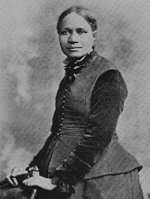Iola Leroy

Iola Leroy or, Shadows Uplifted, an 1892 novel by Frances Harper, is one of the first novels published by an African-American woman. While following what has been termed the "sentimental" conventions of late nineteenth-century writing about women, it also deals with serious social issues of education for women, passing, miscegenation, abolition, reconstruction, temperance, and social responsibility.
Plot summary
Iola Leroy, or Shadows Uplifted (1892), is the story of Iola Leroy, a beautiful young mixed-race woman of majority white ancestry in the antebellum years. Born free in Mississippi, she and her brother Harry are the children of a wealthy white planter and his mixed-race wife, a former slave whom he freed and married before the American Civil War. (Note: Such interracial marriage was then illegal, although planters wealthy enough sometimes flouted the law). Her father sends Iola to the North to be educated. After his death, Iola is kidnapped, told that she has black blood, and sold into slavery in the Deep South.
In a plot that follows the conventions of the late nineteenth century tragic mulatto genre, Iola struggles to elude the intentions of her various owners to use her sexually. After she is freed by the Union Army during the war, she seeks to find her scattered family members. Embracing her African heritage, she works to improve the social and economic condition of blacks in the United States.
Iola is supported in her struggle by people who relate to various aspects of her complicated life: a devoted former Leroy family slave, Tom Anderson, rescued Iola from a lecherous master. Her brother Harry Leroy joins her in refusing to "pass" as white, although that would make life easier for them. (Note: Both Leroys have a majority of white ancestry.) She meets a newfound uncle, Robert Johnson, who introduces her to her dark-skinned maternal grandmother Harriet, of mostly African descent.
After the war, Leroy continues to identify as black. She declines to pass for white when her New England suitor, Dr. Gresham, makes it a condition of his proposal of marriage. He wants her to promise never to reveal her African ancestry.[1]
Leroy marries Dr. Frank Latimer, a man of mixed ancestry who also identifies with the black community. They return to North Carolina to fight for "racial uplift." After a series of coincidences, Iola Leroy Latimer reunites with her surviving Leroy family members after the war.
Literary significance and criticism
Iola Leroy was for some time cited as the first novel by an African-American author. Professor Henry Louis Gates, Jr.'s 1982 discovery of Harriet Wilson's Our Nig (1859) displaced it from that spot. Later, William Wells Brown's 1853 novel Clotel, or the President's Daughter, although first published in England where he was living at the time, came to be viewed as the first novel by an African-American author.
Harper's novel remains important as one of the earliest novels written by an African American and as a fictional work dealing with complex issues of race, class, and politics in the United States. Recent scholarship suggests that Harper's novel provides a sophisticated understanding of citizenship, gender, and community, particularly the way that African Americans developed hybrid forms of gemeinschaft and gesellschaft before, during, and after slavery.[2]
References
- ↑ Logan, Shirley W. "Iola Leroy," Masterplots II: African-American Literature Series, Salem Press, 1994
- ↑ Hollis Robbins, Ed. "Introduction," Iola Leroy, or, Shadows Uplifted, Penguin Classics, 2010
External links
- Iola Leroy at Project Gutenberg
- Terry Novak, Iola Leroy, Literary Encyclopedia
-
 Iola Leroy public domain audiobook at LibriVox
Iola Leroy public domain audiobook at LibriVox